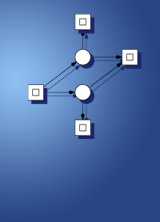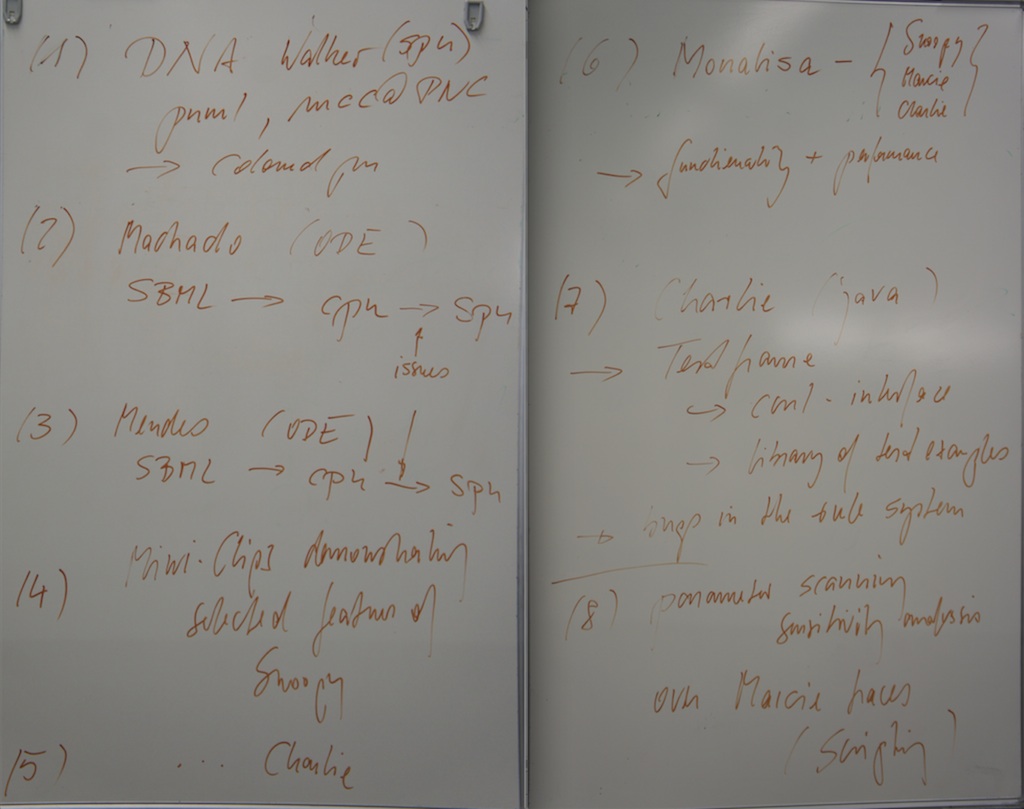
- PhD Tutorial 2017
- BioPPN 2016
- Beijing 2015
- BioPPN 2015
- BioPPN 2014
- Petri Nets 2014
- BioPPN 2013
- Petri Nets 2013
- BioPPN 2012
- ICSB 2011
- BioPPN 2011
- AWPN 2010
- ISS - BioPN 2010
- BioPPN 2010
- Petri Nets 2009
- APBC 2009
- ISMB 2008
- BioSysBio 2008
data structures and software dependability
computer science department
brandenburg university of technology cottbus - senftenberg
T U T O R I A L - BioModel Engineering with Petri Nets
latest update: April 05, 2019, at 12:22 AM
still under construction
This page provides a collection of material (papers, slides and biochemically interpreted Petri nets) illustrating selected aspects of BioModel Engineering; used, e.g., for the PhD course held at the Graduate School of the Ca' Foscari University Venezia/Italy in July 2016.
Index
- Basic materials
- Tools
- Introduction
- Qualitative Petri nets (QPN)
- Stochastic Petri nets (SPN)
- Continuous Petri nets (CPN)
- Hybrid Petri nets (HPN)
- Coloured Petri nets
- Genome-scale models
Basic materials
- [BHM15]
MA Blätke, M Heiner and W Marwan:
BioModel Engineering with Petri Nets;
In Algebraic and Discrete Mathematical Methods for Modern Biology, (R Robeva, Ed.), Elsevier Inc., pages 141–193, March 2015. [ url ] [ doi ] [ BibTeX ]
(Textbook chapter, introducing QPN, SPN, CPN, HPN and its coloured counterparts, without any formal definitions.) - all pn's for figures and running example in [BHM15]
- [HGD08]
M Heiner, D Gilbert and R Donaldson:
Petri Nets for Systems and Synthetic Biology;
In SFM 2008, (M Bernardo, P Degano and G Zavattaro, Eds.), Springer, pages 215–264, 2008. [ pdf ] [ doi ] [ BibTeX ]
(Textbook chapter, introducing QPN, SPN, and CPN; provides also formal definitions for most technical notions.) - [BHM11]
MA Blätke, M Heiner, and W Marwan:
Tutorial - Petri Nets in Systems Biology;
Technical report, Otto von Guericke University Magdeburg, Magdeburg Centre for Systems Biology, August 2011. [ pdf ] [ BibTeX ]
(A self-contained tutorial, Chapter 8 might also serve as a brief Charlie manual.)
Tools
- Snoopy - GUI tool to construct, animate and simulate Petri nets (QPN, SPN, CPN, HPN, and their coloured counterparts)
- Charlie - GUI tool for QPN analysis by standard Petri net theory
- Marcie - CLI tool for QPN and SPN analysis, including model checking
- Spike - CLI tool for continuous, stochastic & hybrid simulation of (coloured) Petri nets
- MC2 - simulative model checking
INTRODUCTION
Slides
- Systems and Synthetic Biology, a brief introduction (slides)
- Petri nets - a bit of history (slides)
- Petri nets in a nutshell (slides)
- Developing Bio Petri nets, four approaches (slides)
Petri nets of some basic structures
- (pn) - to introduce the firing rule: 2H2 + O2 -> 2H2O
- (pn) - some basic scenarios
- (pn) - metabolic vs. signal transduction networks
- (pn) - transcription + translation (gene - mRNA - protein)
- (pn) - layout options - (screenshot)
hints re web-based animation:
- logical nodes not highlighted;
- firing of logical transitions/hierarchy buggy;
- no support of splines, constants;
- download the net and animate locally; when opening the net, chose 'do nothing'.
Petri nets of some case studies
- (pn) - combined glycolysis/pentose phosphate pathway in erythrocytes [Reddy 1994], [H98.sld], ..., [H16.mcc]
- (pn) - apoptosis [GON 2003], [HKW04], [HK04]
- (pn) - RKIP/ERK signalling pathway, inspired by [Cho 2003]; [GH06], [HDG10]
- (pn) - signalling cascade, inspired by [Levchenko 2000]; [GHL07b], [HGD08]
- (pn) - self-powered biosensor template [GHR+08]
- (pn) - repressilator, inspired by [Phillips 2008]; [LH14]
- (pn) - circadian clock, inspired by [Vilar 2002]; [BHM15]
- (pn) - Lotka–Volterra system (prey/predator)
- (pn) - E. coli core [SGH18]
QUALITATIVE PETRI NETS (QPN)
synopsis
- (slides) - properties and related analysis techniques
partial order versus interleaving semantics
- (pn) - example RKIP/ERK signalling pathway
- partial order semantics: (pn) - one partial order run
- interleaving semantics: (slides) - reachability graph (occurrence graph, marking graph)
structural and behavioural properties
- (pn) - orthogonality of boundedness, liveness, reversibility
- (pn) - static vs dynamic conflicts
- (pn) - various boundedness and liveness degrees, compare Fig. 7 in [HGD08]
- (pn) - a simple example, see Fig. 12 in [HGD08] for its reachability graph
- (pn) - net classes (SM, SG, FC/EFC, ES); for formal definitions see Def. 7 in [HGD08]
place/transition invariants
- (slides) - T-invariants
- (pn) - (slides) - transition invariants / elementary modes / extreme pathways
- (slides) - modularisation by T-invariants
- for formal definitions see Def. 8 in [HGD08]
- (pn) - to introduce T-invariants
- (pn) - ex mass-action component (live) and its P/T-invariants
- (pn) - another example, compare Fig. 8 in [HGD08]
- (pn) - basic structures of P/T-invariants
- (pn) - combinatorial explosion of P/T-invariants
- structured T-invariant representation using atomic fragments
- pseudo-code algorithm for invariant computation, Algorithm 1 in [H09]
- modular computation of invariants
siphon / trap / bad siphon
- for formal definitions see Def. 9, 10, and Theorem 1 in [HGD08]
- (pn) - siphon / trap / bad siphon, compare Fig. 11 in [HGD08]
- (pn) - a minimal P-invariant properly containing a bad siphon, see slides for more details;
model checking
- a crash course in temporal logics (slides)
- (pn) - ex travel preparation; (ctl queries for Charlie) - (ctl queries for Marcie)
- ex circadian clock (bounded version); (andl file ready for mc) - (ctl queries for Marcie)
STOCHASTIC PETRI NETS (SPN)
Slides
- (slides) - Markov chains and functional safety, an introduction
- (slides) - stochasticity, explained by mass/action pattern [Gilmore, SFM2008]
Stochastic Petri nets of some case studies
- (spn) - transcription + translation (gene - mRNA - protein)
- (spn) - (partial order run) - RKIP/ERK signalling pathway
- (spn, unbounded) - (spn, bounded) - repressilator [LH14]
- (spn) - lac operon, an example of prokaryotic gene regulation (using a scheduled transition) [Lehr07]
- (spn) - phosphate regulation (using immediate and scheduled transitions) [MRH12]
- (spn) - (spn with constants) - Lotka–Volterra system (prey/predator)
hints re web-based animation:
- inhibitory arcs buggy
- no support of stochastic animation/simulation
CONTINUOUS PETRI NETS (CPN)
. . . from Petri nets to Ordinary Differential Equations (ODEs)
Slides
- (slides) - a cpn uniquely defines an ODEs
- (slides) - a case study: the RKIP/ERK signalling pathway [HDG10]
- (slides) - a case study: signalling cascade [HGD08]
- (slides) - a case study: hypoxia [HS10]
HYBRID PETRI NETS (HPN)
Slides
COLOURED PETRI NETS
. . . from Petri nets to Partial Differential Equations (PDEs)
- (slides) - and then there was colour
. . . more case studies
GENOME-SCALE MODELS
Slides
(slides) - BioModel Engineering for genome-scale models
